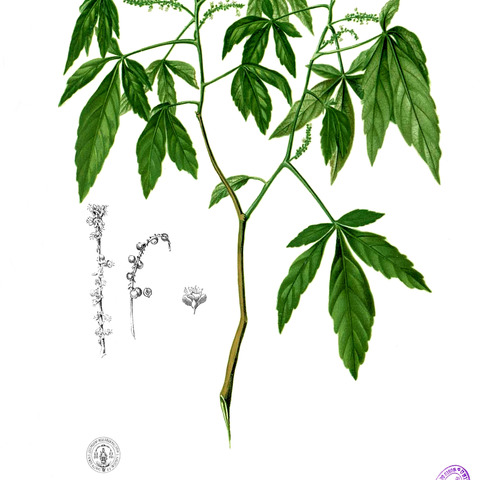Shrubs, rarely trees [rarely woody climbers], monoecious or dioecious. Leaves digitate, stipules absent; leaflets 1-5, petiolate or subsessile, usually serrate, sometimes entire. Thyrses axillary, racemose or compound racemose; bracts and bracteoles subulate or lanceolate, small. Flowers unisexual, zygomorphic, closed, small. Sepals 4, concurved, outer 2 elliptic, slightly smaller, inner 2 suborbicular. Petals 4, each 2 in a pair, adaxially with scales at base. Disk 4-sect, lobes glandlike, apex truncate or obtuse. Stamens (male flowers) 8, sometimes fewer, exserted; filaments free or connate below middle. Ovary (female flowers) 2(or 3)-partitioned, 2-loculed, lobes subglobose or obovate; ovules 1 per locule, inserted near base of middle axis; style basilar, entire or 2-or 3-lobed nearly to base; stigma recurved. Fruit parted into 2 or 3 schizocarps, often only 1 developed, berrylike, subglobose or obovoid, base with rudimentary style and small, globose, sterile schizocarp, exocarp fleshy, juicy, endocarp crustaceous. Seeds nearly same as schizocarp in shape; embryo arched, reflexed. 2n = 28.
Small trees or understory shrubs. Stipules wanting. Leaves alternate, trifoliolate or less often unifoliolate; petioles as long as the blade or shorter; leaflets entire or serrate. Inflorescence a racemiform or paniculate thyrse, with flowers in lateral cincinni. Flowers zygomorphic, functionally pistillate or staminate; calyx 4(5)-merous, with bilateral or dorsiventral-transverse symmetry; petals 4, auriculate or with a bifid appendage; disc unilateral, semi annular, 4-lobed or less often 2-lobed; stamens 8, the filaments unequal, connate at base, variously pubescent or glabrous; ovary 2(3)-carpellate, with a single ovule per carpel. Fruit of 1(-2) basally connate, monocarps (one of them usually much smaller or one or two carpels aborted or rudimentary), each monocarp late, irregularly dehiscent, with fleshy exocarp, and with a crustose or woody endocarp. Seeds exarillate, with papery testa.
Monoecious erect or scrambling shrubs. Branchlets with simple hairs and lenticels. Leaves trifoliolate, occasionally 1-or 5-foliolate; leaflets petiolulate to sessile, the lamina serrate to subentire, semicoriaceous, dotted. Inflorescence axillary, spike-like with scattered fascicles of flowers, rarely branched; bracts small. Flowers small, irregular, unisexual. Sepals 4, paired, broadly imbricate, outer pair smaller; elliptic or suborbicular, concave, membranous, gland-dotted. Petals 4, unilateral, spathulate, long-clawed; scales 2-lobed, pilose, crestless. Disc unilateral, 4-lobed or with 2–4 glands. Stamens 8, opposite disc; filaments filiform. Ovary deeply 2-or 3-lobed, segments 1-locular, 1-ovuled; style filiform; stigma 2-lobed. Fruit usually 1-lobed, drupaceous or nearly dry, indehiscent. Seed obovoid, exarillate.
Trees, shrubs or woody climbers, monoecious or dioecious. Leaves 1–3(–4)-foliolate, often minutely glandular beneath. Flowers small, slightly irregular, sessile or shortly pedicellate, in several-flowered cymules which are densely or more openly placed along simple raceme-like axes or branched axes thus appearing paniculate; cymules sessile or shortly stalked. Sepals 4, unequal, imbricate.. Petals 4, spathulate with internal ciliate scale.. Disk unilateral, 2–4-lobed. Stamens 8, placed to one side of the disk; reduced to staminodes in female flowers. Ovary 2–3-locular, deeply 2–3-lobed, the lobes subglobose, with 1 basal ovule in each; style semigynobasic, 2–3(–4)-fid. Fruit usually red, 1–2(–3)-lobed and seeded, drupe-like, the abortive lobes not persisting. Seeds straw-coloured, ellipsoid to globose, without an aril.
Polygamous shrubs or small trees. Leaves (1-)3(-5)-foliolate, petiolate, exstipulate; leaflets entire or serrate, often punctate or lineolate. Inflorescences axillary, racemiform or loosely paniculate. Flowers irregular, small, pedicellate, globose or often closed at anthesis; sepals 4, imbricate, in opposite pairs, the other two smaller, cucullate, membranous, glabrate or barbate within; petals 4, spat-ulate, the petal scale short, bifid or V-shaped; disc unilateral, lobate or with 4 obtuse glands; stamens 8, eccentric; ovary eccentric, usually of 2 cells, bilobed, the style 2-or 3-lobate, eccentric in fruit, the ovules solitary, ascending from the base of the cell. Fruit a single (rarely 2) obovoid-globular, indehiscent, dry or fleshy coccus; seed obovoid with a short aril.
Flowers monoecious (? rarely polygamo-dioecious) usually male and female in the same inflorescence (the female usually apparently hermaphrodite but the anthers sterile), small, greenish, white or yellowish.
Petals 4, clavate or spathulate with an emarginate apex, each with a usually (always in our species) hairy scale.
Stamens 8 (rarely fewer), slightly connate at the base, somewhat shorter in the female flowers (staminodes).
Seeds obovoid, without arillodes, usually (always in our species) glabrous.
Fruit drupaceous, of 2–3 cocci or frequently of 1 coccus by abortion.
Leaves (1) 3-foliolate, usually minutely glandular beneath.
Ovary deeply 2–3-lobed; loculi 1-ovulate; style 2–3-fid.
Inflorescence a racemoid or paniculate thyrse.
Sepals 4, the 2 outer ones larger, imbricate.
Disk unilateral, usually 4-lobed.
Trees or shrubs.

